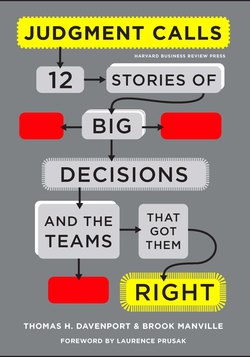Читать книгу Judgment Calls - Thomas H. Davenport - Страница 17
На сайте Литреса книга снята с продажи.
The Flight Readiness Review
ОглавлениеToday, the flight readiness reviews held at Kennedy Space Center before a scheduled launch date bring technical teams and managers together in one room, including representatives from three domains: program, engineering, and safety—about 150 people in the case of the STS-119 review. The importance of gathering them in one place, face-to-face, is clear when you contrast such a meeting with the Challenger teleconference, or any teleconference for that matter, where inattention, misunderstanding, and incomplete communication are common.
The FRR is preceded by a series of smaller team meetings and technical reviews to discuss and analyze issues that will come up in the formal FRR. There are likely to be fifty teams working on specific technologies, projects, and subsystems. These meetings are part of an ecology of decision-making redundancies, integrated tightly into an overall and well-orchestrated process of problem solving. Overlapping authorities and tasks increase the odds of exposing potential issues and uncertainties—they can't fall through the cracks if there are no cracks. This way of working, and the culture by which the entire process is facilitated, also gives early and ample opportunity for people to speak out when they see a problem. Mike Ryschkewitsch, NASA's chief engineer, says, “You know one of the things that NASA strongly emphasizes now is that any individual who works here, if they see something that doesn't look right, they have a responsibility to raise it, and they can raise it … for example, you have whole communities of experts throughout NASA whose whole life is about maximizing safety to the crew.”
In large part thanks to all that preliminary work, many FRRs are fairly routine. Problems have been identified, analyzed, and solved beforehand. Representatives of the teams that carried out that technical work present their results to the group as a whole and have the knowledge they need to answer the questions their colleagues may raise. The STS-119 review—which actually became a series of reviews—was unusual. The technical problem about the engine valve first noted was barely understood at the time of the first FRR and not resolved to the satisfaction of many participants at a second, marathon session. It took three meetings to arrive at “go” for launch. That “decision about the decision making” showed that the FRR is not a rubber stamp on a foregone conclusion; it demonstrated Ryschkewitsch's claim that people at NASA felt free to delay flights over technical concerns, putting flight safety ahead of schedule and productivity. Though the process of problem solving and decision making is well structured, the culture of dissent and open exchange balances and gives critical flexibility to what might otherwise be a dangerously rote activity.
